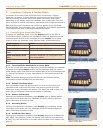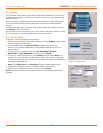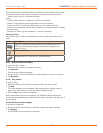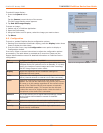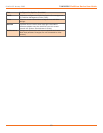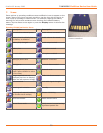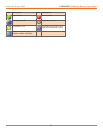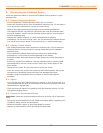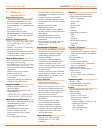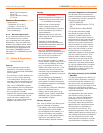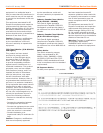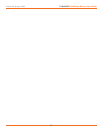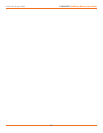
24
TANDBERG FieldView Device User Guide
D14041.02 January 2008
• Rated Input Frequency:
50–60 Hz
• Input Frequency Range:
47–63 Hz
OP e r A t i n g en V i r O n m e n t
• Temperature:
• Operating: 0° to 40° C
• Storage: –20° to 60° C
• Operating humidity: 5–80%
(non-condensing)
9.1.1. Service Information
If you encounter difculties with
the FieldView Device, contact
your corporate technical support
department. They will determine
whether the problem exists within
the network infrastructure or the
FieldView Device equipment and
will contact TANDBERG Support.
See page 2 for TANDBERG contact
information.
10. Safety&Regulatory
Information
General
• Do not attempt to service this
equipment. All repairs must be
done by an authorized TANDBERG
service depot.
• Do not block or insert objects into
the air vents or other openings
in the equipment. Doing so may
damage internal components and
may cause re or shock hazards.
• Use only a TANDBERG-supplied
power adapter with the equipment.
Use of other adapters may cause
re or explosion hazards.
• Operate the external power adapter
in a well ventilated area. Do not
cover the power adapter with
papers or any other items as the
adapter may become hot.
Battery
CAUTION!
Riskofexplosionifbatteryis
replacedbyanincorrecttype
orinstalledincorrectly.
Observe the correct polarity •
when changing the lithium
battery. Install battery according
to the manufacturer’s product
documentation.
Replace battery only with the •
same type as recommended by
the manufacturer.
Dispose of used batteries •
according to the manufacturer’s
product documentation and local
disposal requirements.
• Use only TANDBERG-supplied
batteries with the FieldView Device.
Use of other types may increase
the risk of re or explosion or
damage to the equipment.
• Do not store the battery in places
where metallic objects may come in
contact with the battery terminals
(e.g. in a pocket with keys, in a
drawer with paper clips, etc.). The
resulting short-circuit can cause
extremely high temperatures that
may damage the battery and cause
burns or res.
• Do not attempt to disassemble
the battery. The battery poses a
burn hazard if handled improperly.
Immediately dispose of a damaged
or leaking battery.
• Do not store or leave the FieldView
Device or FieldView Device
battery near a heat source (e.g.
radiator, stove, heater, automobile
dashboard, etc.) as the battery
may explode or ignite.
BatteryDisposal
The uses a Lithium-Ion battery and
must be disposed of properly:
• The battery must not be disposed
with household or ofce waste.
• Do not dispose of the battery in a
re as the battery may explode.
• Contact your local waste disposal
agency for the address of the
nearest battery disposal location.
EuropeanRegulatoryInformation
This product meets the essential
health and safety requirements and
is in conformity with the relevant EU
Directives listed below:
• R&TTE 1999/5/EC
• EU Low Voltage Directive 72/23/
EEC
• EU EMC Directive 89/336/EEC
This product has been tested
and found to comply with EN
61000-6-2:1999 Immunity for
Industrial Environments. When in
the presence of high levels of radio-
frequency electromagnetic elds,
the user may notice interference
within the audio or video content
present on the equipment. If this
occurs the user should re-orient
the equipment or increase the
separation between the equipment
and the interfering source. If an
external audio headset is being
used and is the receiving source
of the interference, the user may
experience improved performance
by using a headset which has been
tested and found to comply with
EN61000-6-2:1999 Immunity for
Industrial Environments.
FCC Class A Notice (S/N: 001000
– 001099)
This device complies with Part 15 of
the FCC Rules. Operation is subject
to the following two conditions: (1)
this device may not cause harmful
interference and (2) this device must
accept any interference received,
including interference that may cause
undesired operation.
This equipment has been tested
and found to comply with the
limits for a Class A digital device,
pursuant to Part 15 of the FCC
Rules. These limits are designed
to provide reasonable protection
against harmful interference when
the equipment is operated in a
commercial environment. This
equipment generates, uses, and can
radiate radio frequency energy and, if
not installed and used in accordance
with the instruction manual, may
cause harmful interference to radio
communications. Operation of this



